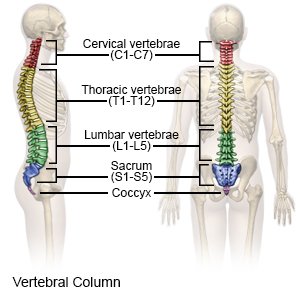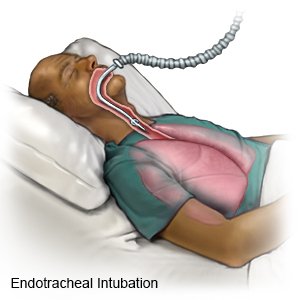Gunshot Wound to the Spine
Medically reviewed by Drugs.com. Last updated on Aug 4, 2025.
A gunshot wound (GSW) to the spine may cause vertebrae fractures or spinal cord damage. Vertebrae are the bones that make up your spine.
 |
WHILE YOU ARE HERE:
Informed consent
is a legal document that explains the tests, treatments, or procedures that you may need. Informed consent means you understand what will be done and can make decisions about what you want. You give your permission when you sign the consent form. You can have someone sign this form for you if you are not able to sign it. You have the right to understand your medical care in words you know. Before you sign the consent form, understand the risks and benefits of what will be done. Make sure all your questions are answered.
Monitoring:
- Telemetry is continuous monitoring of your heart rhythm. Sticky pads placed on your skin connect to an EKG machine that records your heart rhythm.
- Pulse oximetry is a device that measures the amount of oxygen in your blood. A cord with a clip or sticky strip is placed on your finger, ear, or toe. The other end of the cord is hooked to a machine. Never turn the pulse oximeter or alarm off. An alarm will sound if your oxygen level is low or cannot be read.
- Intake and output may be measured. Healthcare providers will keep track of the amount of liquid you are getting. They also may need to know how much you are urinating. Ask healthcare providers if they need to measure or collect your urine.
- Neuro checks may show damage to your spinal cord. Your hand grasp and leg strength may be tested. Your healthcare provider may test how well you can feel pressure or pain in your arms or legs.
Medicines:
- Antibiotics may be given to help treat or prevent an infection caused by bacteria.
- Pain medicine may be given. Do not wait until the pain is severe before you ask for more medicine.
- Steroids may be given to decrease swelling and help blood flow to your spinal cord.
- A tetanus shot may be given. Tetanus is a severe infection. Tell your healthcare provider if you have had the tetanus vaccine or a tetanus booster within the last 5 years.
- You may need extra oxygen if your blood oxygen level is lower than it should be. You may get oxygen through a mask placed over your nose and mouth or through small tubes placed in your nostrils. Ask your healthcare provider before you take off the mask or oxygen tubing.
Tests:
- Blood and urine tests may be done to monitor your condition. They may provide information about your overall condition.
- An x-ray, ultrasound, CT, or MRI may be done to monitor your condition. You may be given contrast liquid to help your organs or blood vessels show up better in the pictures. Tell the healthcare provider if you have ever had an allergic reaction to contrast liquid. Do not enter the MRI room with anything metal. Metal can cause serious injury. Tell the healthcare provider if you have any metal in or on your body.
Treatment:
- A blood transfusion may be needed if you have severe bleeding from your GSW.
- IV fluids may be given to prevent dehydration and increase circulation to major organs.
- Bed rest may limit or prevent damage to your spinal cord.
- Surgery may be needed to repair damage to your vertebrae or structures that support your spinal cord. It may also be needed to clean your GSW or remove the bullet. Your healthcare provider can close your GSW with stitches or staples. Your GSW may need to be left open to allow swelling to decrease and tissues to heal.
- A ventilator is a machine that gives you oxygen and breathes for you when you cannot breathe well on your own. An endotracheal (ET) tube is put into your mouth or nose and attached to the ventilator. You may need a trach if an ET tube cannot be placed. A trach is a tube put through an incision and into your windpipe.
Other treatments:
You may need other treatments if your GSW causes a spinal cord injury. These may include the following:
- A nasogastric (NG) tube may be inserted to remove air, fluid, or blood from your stomach. A NG tube is a long, thin, flexible tube inserted through your nose and down into your stomach or small intestine. You may be fed through a nasogastric tube if you cannot eat normally.
- A Foley catheter is a tube put into your bladder to drain urine into a bag. You may not be able to urinate normally after a spinal cord injury. It will help your healthcare provider check how well your kidneys are working. Keep the bag below your waist. This will prevent urine from flowing back into your bladder and causing an infection or other problems. Also, keep the tube free of kinks so the urine will drain properly. Do not pull on the catheter. This can cause pain and bleeding, and may cause the catheter to come out.
- An endotracheal tube may be inserted to protect your airway and help you breathe. If you have damage to your spinal cord, you may not be able to breathe on your own. An endotracheal (ET) tube is a hollow plastic tube that is placed in your trachea through your mouth. The trachea is also called the windpipe or airway. The ET tube is attached to a machine called a respirator. A respirator gives you oxygen and breathes for you when you cannot breathe on your own.

RISKS:
You may have severe bleeding, paralysis, or lead poisoning from the bullet. You may also get an infection.
CARE AGREEMENT:
You have the right to help plan your care. Learn about your health condition and how it may be treated. Discuss treatment options with your healthcare providers to decide what care you want to receive. You always have the right to refuse treatment.© Copyright Merative 2025 Information is for End User's use only and may not be sold, redistributed or otherwise used for commercial purposes.
The above information is an educational aid only. It is not intended as medical advice for individual conditions or treatments. Talk to your doctor, nurse or pharmacist before following any medical regimen to see if it is safe and effective for you.
Learn more about Gunshot Wound to the Spine
Care guides
Further information
Always consult your healthcare provider to ensure the information displayed on this page applies to your personal circumstances.
